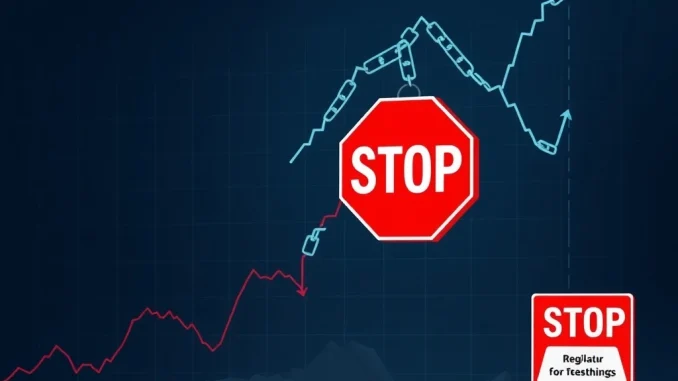
The cryptocurrency market is no stranger to volatility, but the recent dramatic plunge of the MOVE token has sent ripples of concern across the digital asset landscape. Experiencing a sharp -15.6% drop, this decline isn’t just another blip on the radar; it’s a stark indicator of deeper issues stemming from major exchange delistings and an intensifying wave of regulatory scrutiny. For anyone invested in or observing the crypto space, understanding the forces at play behind MOVE’s collapse offers crucial insights into the evolving dynamics of compliance, liquidity, and investor confidence.
The Unraveling of the MOVE Token: A Volatile History Meets Hard Reality
The MOVE token, an asset that has historically flirted with significant price swings, recently entered a new phase of distress. Its dramatic -15.6% drop in a single day, as reported by CryptoPulse Alert, isn’t an isolated event but rather the culmination of a series of escalating pressures. For months, market participants have watched as whispers of uncertainty around MOVE’s operations grew louder, culminating in the decisive actions taken by prominent cryptocurrency exchanges and regulatory bodies. This recent plunge serves as a potent reminder that in the fast-paced world of digital assets, fundamental weaknesses can quickly lead to market-wide repercussions.
The Domino Effect: Major Crypto Delistings Intensify Pressure
One of the most immediate and impactful factors contributing to MOVE’s decline has been the widespread crypto delisting from key trading platforms. In recent weeks, several prominent exchanges, which once facilitated robust trading for MOVE, have opted to remove the token from their listings. These decisions weren’t made lightly; they often stem from a complex web of compliance requirements and growing regulatory uncertainty surrounding the asset. When an exchange delists a token, it sends a clear signal to the market: the asset no longer meets the platform’s stringent standards, whether due to perceived legal risks, insufficient liquidity, or a lack of transparency from the project team. This move directly erodes investor confidence, compounding the token’s already steep price decline and making it increasingly difficult for holders to liquidate their positions.
Mounting Pressure: Why Regulatory Scrutiny is a Game Changer
Beyond exchange actions, the heightened regulatory scrutiny surrounding MOVE has played a pivotal role in its recent struggles. Several regulatory authorities across different jurisdictions have issued public warnings, explicitly highlighting the risks associated with investing in MOVE. These statements often point to a critical lack of transparency concerning the token’s underlying operations, governance structures, and even its true utility. Regulators are increasingly emphasizing the need for projects to provide clear, auditable information to protect investors from potential scams or highly speculative assets with little intrinsic value. Such official warnings carry significant weight, urging investors to exercise extreme caution and fully consider the elevated risks involved in holding assets like MOVE. This increased oversight signals a maturing, albeit sometimes painful, phase for the broader digital asset market, where compliance is no longer optional but essential for survival.
Liquidity Crisis: How Market Sentiment Drove the Cryptocurrency Price Down
The combined force of exchange delistings and regulatory warnings has had a devastating impact on MOVE’s liquidity. For any asset, liquidity is paramount; it refers to how easily an asset can be converted into cash without affecting its market price. With fewer exchanges supporting MOVE, the avenues for investors to trade or exit their positions have severely diminished. This scarcity of active trading venues has led to several detrimental effects:
- Wider Bid-Ask Spreads: The gap between the highest price a buyer is willing to pay (bid) and the lowest price a seller is willing to accept (ask) has widened significantly. This means investors often have to sell at a much lower price than they might otherwise, incurring greater losses.
- Increased Price Instability: With less trading volume, even small buy or sell orders can cause dramatic price swings, making the asset even more unpredictable.
- Deterred Participation: Both institutional and retail investors are wary of illiquid assets. The inability to enter or exit positions efficiently deters new money from flowing into the token, further exacerbating its decline.
As a direct consequence, market sentiment has turned overwhelmingly negative. The lack of trading opportunities, coupled with the ongoing regulatory concerns, creates a vicious cycle where a declining cryptocurrency price further erodes confidence, pushing more holders to sell, which in turn drives the price down even further.
Beyond MOVE: What Does This Mean for Broader Altcoin Volatility?
Analysts are quick to point out that MOVE’s troubles aren’t just about one token; they highlight structural vulnerabilities prevalent in many speculative altcoins. Issues such as unclear or non-existent use cases, a lack of real-world adoption, and limited developer activity are frequently cited as critical concerns. In the case of MOVE, these fundamental weaknesses, combined with the recent regulatory spotlight, have raised serious questions about the project’s long-term sustainability and viability. The market’s reaction to MOVE’s decline serves as a potent warning for other projects that rely heavily on speculative demand rather than robust fundamentals. This incident reinforces the idea that the era of ‘anything goes’ in crypto is rapidly fading, replaced by a growing demand for transparency, utility, and regulatory alignment.
The implications for broader altcoin volatility are significant. Investors are becoming increasingly discerning, prioritizing projects with well-defined roadmaps, active development, clear governance structures, and a proactive approach to regulatory compliance. Tokens that fail to meet these evolving standards are likely to face similar pressures, potentially leading to further market corrections and consolidation within the altcoin space. The ‘flight to quality’ is becoming a defining characteristic of the current crypto market.
A Call for Clarity: Rebuilding Trust in the Digital Asset Space
In the wake of MOVE’s dramatic fall, industry participants have amplified their calls for greater transparency from the MOVE team and its partners. Many stakeholders emphasize the urgent need for clear governance structures, auditable financial reporting, and open communication channels to rebuild any semblance of trust. Without such fundamental measures, analysts project that the token will continue to struggle in the highly competitive crypto market. The ability of a project to provide verifiable information about its operations, treasury, and development progress is no longer a luxury but a necessity for attracting and retaining investor confidence. The MOVE case serves as a stark reminder that in the absence of accountability, even once-popular tokens can quickly fall from grace.
Lessons from MOVE – The Path Forward
The path forward for the MOVE token remains highly uncertain. With ongoing delistings, persistent regulatory warnings, and a severe lack of liquidity, the project faces an uphill battle. To regain any traction, MOVE must address the fundamental concerns around its governance, transparency, and utility. This would likely involve significant restructuring, clear communication with the community, and a concerted effort to demonstrate genuine value and compliance. Until such measures are demonstrably implemented, the token is likely to remain on the periphery of mainstream crypto markets, serving as a cautionary tale about the perils of opaque operations in a rapidly maturing regulatory environment. For investors, the saga of MOVE underscores the critical importance of rigorous due diligence and prioritizing projects that champion transparency, strong fundamentals, and a clear path to sustainable adoption.
Frequently Asked Questions (FAQs)
Q1: What is the current status of the MOVE token?
A1: The MOVE token is currently experiencing significant price decline and reduced liquidity due to major exchange delistings and intensifying regulatory scrutiny. Its future remains highly uncertain without substantial changes to its transparency and governance.
Q2: Why are major exchanges delisting MOVE?
A2: Exchanges are delisting MOVE primarily due to compliance requirements and regulatory uncertainty. They cite concerns about the token’s underlying operations, governance, and potential risks, making it difficult for them to continue supporting its trading.
Q3: What are the regulatory concerns surrounding MOVE?
A3: Regulatory authorities have issued warnings regarding MOVE, emphasizing a lack of transparency in its operations and governance. They urge investors to exercise caution due to the elevated risks associated with holding such an asset.
Q4: How do these delistings affect MOVE’s liquidity?
A4: Delistings severely impact MOVE’s liquidity by limiting trading venues. This leads to wider bid-ask spreads, increased price instability, and deters both institutional and retail participation, making it difficult for investors to buy or sell the token efficiently.
Q5: What are the broader implications of MOVE’s decline for the crypto market?
A5: MOVE’s decline reinforces the growing importance of compliance, transparency, and strong fundamentals in the digital asset space. It signals that investors are increasingly prioritizing projects with well-defined use cases and regulatory alignment, potentially leading to further consolidation and a ‘flight to quality’ among altcoins.
Q6: What should investors consider before investing in similar tokens?
A6: Investors should conduct thorough due diligence, prioritizing projects with clear use cases, active development, transparent governance structures, and a demonstrated commitment to regulatory compliance. Be wary of tokens that lack transparency or rely solely on speculative demand.



